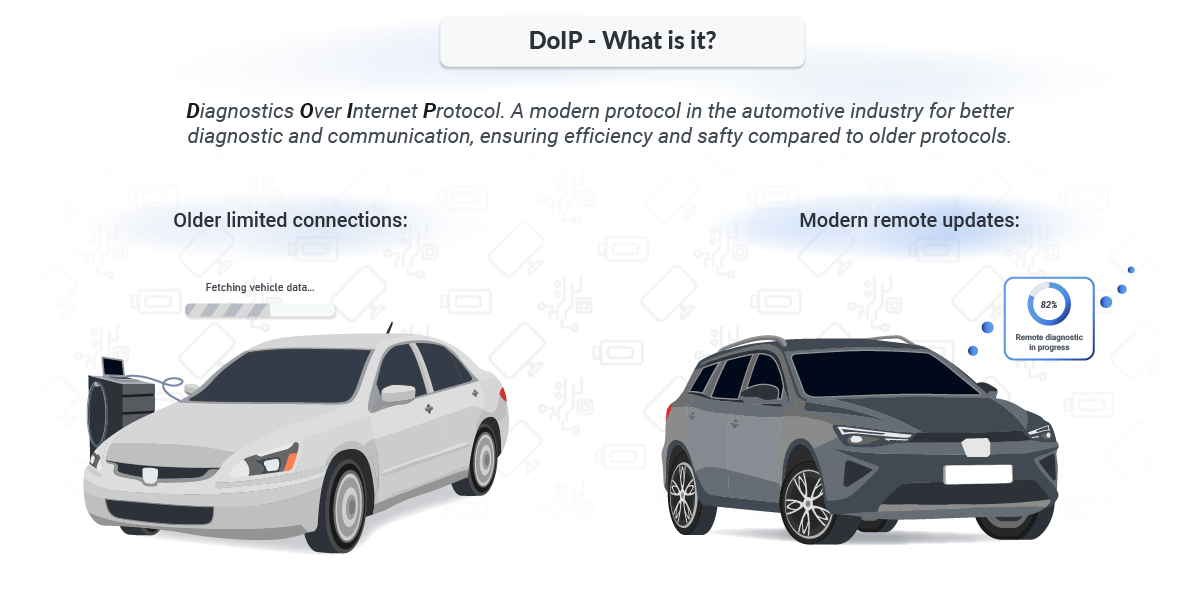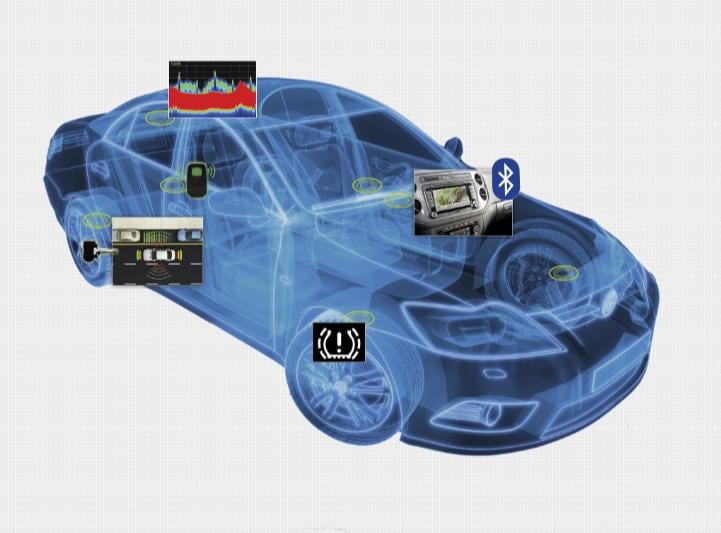Faster Delivery in 3-5 Days
Faster Delivery in 3-5 Days

New generation cars are no longer simple mechanical vehicles, but complex electronic systems with increasingly advanced and interconnected control units. Therefore, vehicle diagnostic tools must also keep up. DoIP and CANFD protocols are now standard in many modern vehicles, especially in high-end brands and electric or hybrid models.
Knowing and using diagnostics compatible with these protocols is essential to avoid errors, limitations and wasted time. In this article, you will learn what they are, why they are needed and which tools to choose to work without limitations.
DoIP (Diagnostics over Internet Protocol) is a communication protocol used in the automotive industry to perform vehicle diagnostics over standard IP-based networks, such as Ethernet.
DoIP enables network-based communication instead of relying on traditional physical connections, allowing diagnostics and software updates to be performed remotely. This is essential for today's vehicles, which feature complex electronic systems and need regular software maintenance.

What is DoIP protocol
CAN FD (Controller Area Network with Flexible Data-Rate) is an enhanced version of the classic CAN (Controller Area Network) protocol used in automotive and industrial applications for communication between electronic control units (ECUs).
The CAN-FD protocol supports higher data transmission speeds and larger payloads than the standard CAN, making communication faster and more efficient. This enables the use of high-resolution sensors, advanced control algorithms, and enhanced diagnostic functions in modern vehicles.

Application of CAN FD protocol in vehicle diagnostics

CAN FD supports a larger payload of up to 64 bytes, enabling faster data transmission.
In recent years, the automotive industry has undergone profound changes: modern cars are increasingly digitalized and equipped with high-performance electronic systems. Each vehicle includes dozens of control units, interconnected by complex networks, managing:
In order to be able to communicate with all these systems, faster, more flexible and more secure protocols must be used. This is where DoIP and CAN FD come into play, which have now become indispensable for performing advanced diagnostics.
Using a diagnostic scanner that is not compatible with DoIP and CAN FD actually means that an increasing number of vehicles in circulation cannot be processed. Newer vehicles require advanced protocols to communicate correctly with the control units.

Autel scanners that support DoIP and CAN FD protocols cover a wider range of vehicle models.
If your diagnostics do not support them, you may not be able to read errors, make adjustments or complete coding. In some cases, the vehicle cannot be recognized. This leads to wasted time, incomplete diagnostics and unhappy customers.
After 2020, many smart/electric models (such as Tesla and Volkswagen MEB platform) rely on DoIP for high-speed diagnosis, and traditional CAN tools may not be able to connect or have limited functions.
Without CAN FD support, data transmission time cannot be significantly reduced by increasing the bit rate and optimizing the frame structure, which increases the diagnostic time. It is also impossible to read the large data streams of high-precision sensors (such as millimeter-wave radar) in real time.
Many advanced systems such as ADAS, infotainment, and connected cars rely on high-bandwidth communications. Tools that do not support DoIP or CAN FD may not be able to accurately diagnose these complex systems.
| Model | DoIP and CAN FD Protocol |
| MX900 | YES |
| MK900 | YES |
| MK900-BT | YES |
| MX900-TS | YES |
| MK900-TS | YES |
| DS900 | YES |
| DS900-BT | YES |
| MP900/MP900E | YES |
| DS900-TS | YES |
| MP900-TS | YES |
| MP900BT/MP900Z-BT | YES |
| MS906Pro | YES |
| MS906Pro-TS | YES |
| MK906 pro/MK906S pro | Yes |
| MK906 pro-TS/MK906S pro-TS | Yes |
| Elite II Pro | YES |
| MS909 | YES |
| MS919 | YES |
| Ultra | YES |
| Ultra Lite/Ultra Lite S | YES |
| Ultra S2 | YES |
Note:
If your Autel diagnostic scanner does not support the CAN FD protocol, you can add an additional CAN FD adapter. The Autel CAN FD adapter is designed to support the diagnosis of models with the CAN FD protocol, including 2018-2020 GM and Ford vehicles.
It works with the Autel Vehicle Communication Interface (VCI) to enable the Autel tablet scanner to communicate and diagnose the vehicle via the CAN FD communication protocol.
The CAN FD Adapter is compatible with MX808 Series, MK808 Series, MS906 Series, MS908 Series, MK908 Series, MP808 Series, DS808 Series, MS908S Series, and Elite scanners to extend support for the CAN FD protocol.
DoIP and CAN FD protocols are very important in vehicle diagnosis. OBD2 scanners that support these two protocols cover a wider range of vehicle models, have higher diagnostic efficiency, are more adaptable to the current development status of the industry, and are more able to meet future functional requirements.
With the advancement of intelligence and electrification trends, the importance of these two technologies will become increasingly prominent, and they are essential support for automotive diagnostic tools and system upgrades.
Leave a comment